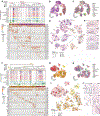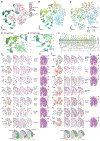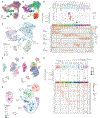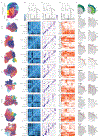A taxonomy of transcriptomic cell types across the isocortex and hippocampal formation
- PMID: 34004146
- PMCID: PMC8195859
- DOI: 10.1016/j.cell.2021.04.021
A taxonomy of transcriptomic cell types across the isocortex and hippocampal formation
Abstract
The isocortex and hippocampal formation (HPF) in the mammalian brain play critical roles in perception, cognition, emotion, and learning. We profiled ∼1.3 million cells covering the entire adult mouse isocortex and HPF and derived a transcriptomic cell-type taxonomy revealing a comprehensive repertoire of glutamatergic and GABAergic neuron types. Contrary to the traditional view of HPF as having a simpler cellular organization, we discover a complete set of glutamatergic types in HPF homologous to all major subclasses found in the six-layered isocortex, suggesting that HPF and the isocortex share a common circuit organization. We also identify large-scale continuous and graded variations of cell types along isocortical depth, across the isocortical sheet, and in multiple dimensions in hippocampus and subiculum. Overall, our study establishes a molecular architecture of the mammalian isocortex and hippocampal formation and begins to shed light on its underlying relationship with the development, evolution, connectivity, and function of these two brain structures.
Keywords: GABAergic; cell type; cortex; excitatory neuron; glutamatergic; hippocampus; interneuron; single-cell RNA sequencing; single-cell transcriptomics.
Copyright © 2021 Elsevier Inc. All rights reserved.
Conflict of interest statement
Declaration of interests The authors declare no competing interests.
Figures







Comment in
-
Seq-ing out cell types across the isocortex and hippocampal formation.Cell. 2021 Jun 10;184(12):3083-3085. doi: 10.1016/j.cell.2021.05.016. Cell. 2021. PMID: 34115970 Free PMC article.
References
-
- Cembrowski MS, and Spruston N (2019). Heterogeneity within classical cell types is the rule: lessons from hippocampal pyramidal neurons. Nat Rev Neurosci 20, 193–204. - PubMed
Publication types
MeSH terms
Substances
Grants and funding
LinkOut - more resources
Full Text Sources
Other Literature Sources
Molecular Biology Databases

